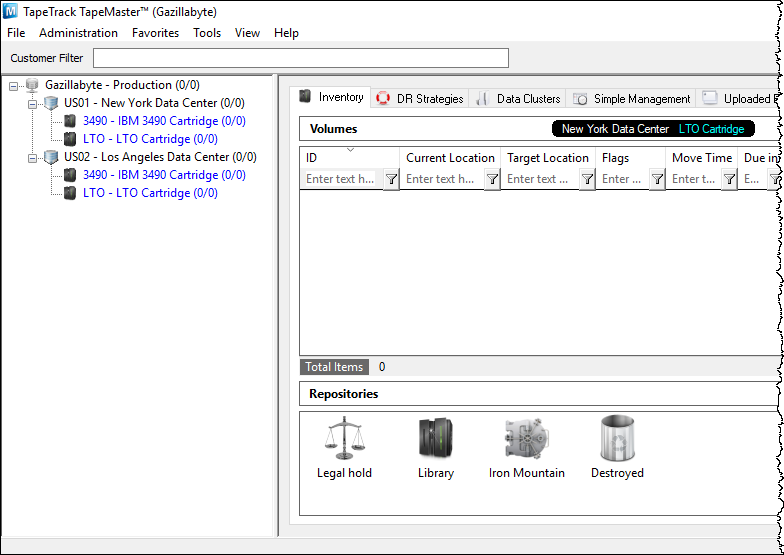This is an old revision of the document!
Table of Contents
TMSS10BatchLoader
Synopsis
TMSS10BatchLoader [-c configuration file] [-S logonstring]
Description
Creates Customer, Media and Repositories by loading a configuration file into the TapeTrack Database.
Options
-cThe config file argument specifies the path to the Batch Configuration File.-SLogon string argument sets the Server logon information.
Editable Fields
- Repository Icon
Technical Support
The TapeTrack Software is commercially supported by a full time help desk staff. If you are experiencing problems or want some advice on how to configure or use the product please see the Accessing Technical Support page.
Exit Statuses
- zero Program has ended successfully.
- non-zero Program has not ended successfully.
Environment
Files
stderr: Diagnostic messages.
Example
Configuration File
Configuration file to create two Customers with attributes:
Customer 0001
- Customer-ID: US01, Customer Description: New York Data Center.
- Media-ID: LTO, Media Description: LTO Cartridge.
- Repository-ID: LIBR, Repository Description: Library, Repository Type: 1, Next Repository: OFFS.
- Repository-ID: OFFS, Repository Description: Iron Mountain, Repository Type: 2.
- Repository-ID: DEST, Repository Description: Destroyed, Repository Type: 6.
- Repository-ID: HOLD, Repository Description: Legal Hold, Repository Type: 4 .
Customer 0002
- Customer-ID: US02, Customer Description: Los Angeles Data Center.
- Media-ID: 3490, Media Description: IBM 3490 Cartridge.
- Repository-ID: LIBR, Repository Description: Library, Repository Type: 1, Next Repository: OFFS.
- Repository-ID: OFFS, Repository Description: Iron Mountain, Repository Type: 2 and Next Repository: LIBR.
Download Sample Configuration file.
setup=
{
customers=
(
{
id="US01"; description="New York Data Center";
media=
(
{
id="LTO"; description="LTO Cartridge";
repositories=
(
{ id="LIBR"; description="Library"; type=3; next="OFFS"; },
{ id="OFFS"; description="Iron Mountain"; type=2; next="LIBR"; },
{ id="DEST"; description="Destroyed"; type=6; },
{ id="HOLD"; description="Legal hold"; type=4; }
)
},
{
id="3490"; description="IBM 3490 Cartridge";
repositories=
(
{ id="LIBR"; description="Library"; type=3; next="OFFS"; },
{ id="OFFS"; description="Iron Mountain"; type=2; next="LIBR"; }
)
}
)
},
{
id="US02"; description="Los Angeles Data Center";
media=
(
{
id="LTO"; description="LTO Cartridge";
repositories=
(
{ id="LIBR"; description="Library"; type=3; },
{ id="OFFS"; description="Iron Mountain"; type=2; }
)
},
{
id="3490"; description="IBM 3490 Cartridge";
repositories=
(
{ id="LIBR"; description="Library"; type=3; },
{ id="OFFS"; description="Iron Mountain"; type=2; }
)
}
)
}
);
};
Command line syntax
TMSS10BatchLoader -S user:-password@localhost -c master.cfg
Output Results
When creating multiple Customers with identical Media Types and/or Repositories it is possible to create a configuration file with these attributes and include it in the master configuration file to save duplication of code blocks.
To create two customers, US01 and US02, with:
- Media-ID: LTO, Media Description: LTO Cartridge.
- Media-ID: 3490, Media Description: IBM 3490 Cartridge.
- Repository-ID: LIBR, Repository Description: Library, Repository Type: 1, Next Repository: OFFS.
- Repository-ID: OFFS, Repository Description: Iron Mountain, Repository Type: 2 and Next Repository: LIBR.
This directive has the effect of inlining the contents of the named file at the point of inclusion.
An include directive must appear on its own line in the input. It has the form:
@include “filename”
Any backslashes or double quotes in the filename must be escaped as ‘\\’ and ‘\“’, respectively.
Configuration Files
include.cfg
media=
(
{
id="LTO"; description="LTO Cartridge";
repositories=
(
{ id="LIBR"; description="Library"; type=3; next="OFFS"; },
{ id="OFFS"; description="Iron Mountain"; type=2; next="LIBR"; }
)
},
{
id="3490"; description="IBM 3490 Cartridge";
repositories=
(
{ id="LIBR"; description="Library"; type=3; next="OFFS"; },
{ id="OFFS"; description="Iron Mountain"; type=2; next="LIBR"; }
)
}
)
master.cfg
setup=
{
customers=
(
{
id="US01"; description="New York Data Center";
@include "include.cfg"
},
{
id="US02"; description="Los Angeles Data Center";
@include "include.cfg"
}
);
};
Command line syntax
TMSS10BatchLoader -S user:-password@localhost -c master.cfg











